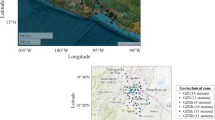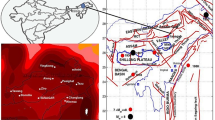Abstract
Seismic response of a utility-scale land-based wind turbine to near-fault pulse-like ground motions is presented in this study. The structural model corresponds to the 5-MW prototype developed by National Renewable Energy Laboratory. Response parameters such as tower-top displacement, base shear, and overturning moment are calculated by time history analysis and response spectral analysis using different estimates of response spectra. The results show that peak ground velocity and the frequency of dominant pulse of the ground motion are critical parameters governing the response, while peak ground acceleration has very weak correlation to response. When the pulse period is in the vicinity of structural period, seismic response is found to be much larger than those imposed by extreme events in design wind loads. Response spectral analysis using the actual spectra obtained from actual ground motions yielded results close to those from time history analysis. The spectral model prescribed in Eurocode8 is found to be inadequate in representing near-fault seismic action on the wind turbine.









Similar content being viewed by others
References
ADAMS (2005) Automatic dynamic analysis of mechanical systems. MSC Software Corporation. http://www.mscsoftware.com/product/adams. Last Accessed 22 Jan 2019
Agbayani NA (2014) A technical overview of ASCE/AWEA RP2011: recommended practice for compliance of large land-based wind turbine support structures. In: Structures congress 2014
Asareh MA (2015) Dynamic behaviour of operational wind turbines considering aerodynamic and seismic load interaction. Ph.D. dissertation, Missouri University of Science and Technology, USA
Asareh M-A, Volz JS (2013). Evaluation of aerodynamic and seismic coupling for wind turbines using finite element approach. ASME 2013 international mechanical engineering congress and exposition. American Society of Mechanical Engineers, San Diego, California, USA, p. V04BTA041
Asareh MA, Schonberg W, Volz J (2016) Fragility analysis of a 5-MW NREL wind turbine considering aero-elastic and seismic interaction using finite element method. Finite Elem Anal Des 120:57–67
Avossa AM, Demartino C, Ricciardelli F (2017) Peak response of HAWTs to wind and seismic actions. In: EACWE 2017-European–African conference on wind engineering
Bazeos N, Hatzigeorgiou G, Hondros I, Karamaneas H, Karabalis D, Beskos D (2002) Static, seismic and stability analyses of a prototype wind turbine steel tower. Eng Struct 24(8):1015–1025
Bir G (2007) Users guide to BModes (software for computing rotating beam coupled modes). National Renewable Energy Laboratory, https://nwtc.nrel.gov/BModes. Last modified 29 Sept 2014; Accessed 23 Jan 2019
Bir G, Jonkman J (2008) Modal dynamics of large wind turbines with different support structures. In ASME 27th international conference on offshore mechanics and arctic engineering, Estoril, Portugal, June 2008
De Risi R, Bhattacharya S, Goda K (2018) Seismic performance assessment of monopile-supported offshore wind turbines using unscaled natural earthquake records. Soil Dyn Earthq Eng 109:154–172
Fogle J, Agarwal P, Manuel L (2008) Towards an improved understanding of statistical extrapolation for wind turbine extreme loads. Wind Energy Int J Prog Appl Wind Power Convers Technol 11(6):613–635
GL (2003) Rules and guidelines: industrial service: guideline for the certification of wind turbines. Germanischer Lloyd, Hamburg
IEC (2005) International electrotechnical commission. IEC 61400-1: wind turbines—part 1: design requirements, 3 edn. IEC, Geneva, Switzerland
Ishihara T, Sarwar M (2008) Numerical and theoretical study on seismic response of wind turbines. In European wind energy conference and exhibition, pp 1–5
Jonkman JM (2007) Dynamics modeling and loads analysis of an offshore floating wind turbine. National Renewable Energy Laboratory Technical Report NREL/TP-500-41958
Jonkman, JM, Buhl ML Jr (2005) Fast user’s guide. National Renewable Energy Laboratory, Golden, CO, Technical Report No. NREL/EL-500-38230
Jonkman JM, Butterfield S, Musial W, Scott G (2009) Definition of a 5-MW reference wind turbine for offshore system development. National Renewable Energy Laboratory Golden, CO
Katsanos E, Sanz AA, Georgakis CT, Thöns S (2017) Multi-hazard response analysis of a 5 MW offshore wind turbine. Proc Eng 199:3206–3211
Kiyomiya O, Rikiji T, Van Gelder PH (2002) Dynamic response analysis of onshore wind energy power units during earthquakes and wind. In: Proceedings 12th international offshore and polar engineering conference, pp 520–526
Lavassas I, Nikolaidis G, Zervas P, Efthimiou E, Doudoumis IN, Baniotopoulos CC (2003) Analysis and design of the prototype of a steel 1-MW wind turbine tower. Eng Struct 25(8):1097–1106
Lombardi L, De Luca F, MacDonald J (2019) Design of buildings through linear time-history analysis optimising ground motion selection: a case study for RC-MRFs. Eng Struct 192:279–295
Mavroeidis GP, Papageorgiou AS (2003) A mathematical representation of near-fault ground motions. Bull Seismol Soc Am 93(3):1099–1131
Myers A, Gupta A, Ramirez C, Chioccarelli E (2012) Evaluation of the seismic vulnerability of tubular wind turbine towers. In: Proceedings of the 15th world conference on earthquake engineering, Lisbon, Portugal 2012, pp 24–28
Nuta E (2010) Seismic analysis of steel wind turbine towers in the Canadian environment. MASc Thesis, University of Toronto
Prowell I (2011) An experimental and numerical study of wind turbine seismic behavior. Ph.D. thesis, University of California
Risø-DNV (2001) Guidelines for design of wind turbines. Wind Energy Department of Risø National Laboratory and Det Norske Veritas, Copenhagen, Denmark
Rupakhety R, Halldorsson B, Sigbjörnsson R (2010) Estimating coseismic deformations from near source strong motion records: methods and case studies. Bull Earthq Eng 8(4):787–811
Rupakhety R, Sigurdsson SU, Papageorgiou AS, Sigbjörnsson R (2011) Quantification of ground-motion parameters and response spectra in the near-fault region. Bull Earthq Eng 9(4):893–930
Rupakhety R, Ólafsson S, Sigurðssson GÖ, Sigbjörnsson R (2016) Site-specific seismic hazard assessment including near-fault and local site effects for the proposed windfarm in the Búffellslundur area in South Iceland. Site response analysis and near-fault effects for seismic resistant design of wind turbine towers in the Búrfellslundur area. Earthquake Engineering Research Centre, University of Iceland, Report No. 16001
Sigurðsson GÖ (2015) Seismic response of wind turbine structures in the near-fault region. M.Sc. thesis, University of Iceland. https://skemman.is/handle/1946/23416
Sigurðsson GÖ, Rupakhety R, Olafsson S (2017) Evaluation of seismic response of large land based wind turbines in the near-fault area using different analysis methods. In Proceedings of the 16th world conference on earthquake engineering, Chile
Witcher D (2005) Seismic analysis of wind turbines in the time domain. Wind Energy 8(1):81–91
Yuan C, Chen J, Li J, Xu Q (2017) Fragility analysis of large-scale wind turbines under the combination of seismic and aerodynamic loads. Renew Energy 113:1122–1134
Zhao X, Maißer P (2006) Seismic response analysis of wind turbine towers including soil–structure interaction. J Multi Body Dyn 220(1):53–61
Zhao X, Maißer P, Wu J (2007) A new multibody modelling methodology for wind turbine structures using a cardanic joint beam element. Renew Energy 32(3):532–546
Acknowledgements
We acknowledge financial support from the University of Iceland research fund. This study was partly funded by the Energy Research Fund of Landsvirkjun, the national power company of Iceland. We thank two anonymous reviewers for their constructive comments that helped to improve the manuscript.
Author information
Authors and Affiliations
Corresponding author
Additional information
Publisher's Note
Springer Nature remains neutral with regard to jurisdictional claims in published maps and institutional affiliations.
Rights and permissions
About this article
Cite this article
Sigurðsson, G.Ö., Rupakhety, R., Rahimi, S.E. et al. Effect of pulse-like near-fault ground motions on utility-scale land-based wind turbines. Bull Earthquake Eng 18, 953–968 (2020). https://doi.org/10.1007/s10518-019-00743-9
Received:
Accepted:
Published:
Issue Date:
DOI: https://doi.org/10.1007/s10518-019-00743-9




